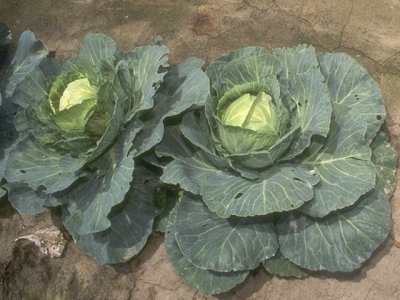Growing Cabbage including Savoy Cabbage in the Vegetable Garden

Growing Cabbage, including Savoy Cabbage
Brassica oleracea capitata
This is another versatile brassica, whose varieties give crops throughout the year. It is quite suitable for small gardens if you are growing cabbage with inter-crops. Of special interest for small gardens is the variety ‘Minicole’, an F1 hybrid which may be grown more closely spaced than ordinary types.
When you are growing cabbage, there are four main seasonal groups of cabbage:
- spring-sown for use in summer and autumn;
- summer-sown for use in autumn and winter;
- autumn-sown for use in spring;
- late-spring-sown Savoy cabbages for use in autumn and winter.
If pressure on space is particularly severe, the autumn-sown varieties may be especially useful to you because they can be harvested and cleared from the plot before your spring and summer plantings of other vegetables get under way.
There is some overlap and flexibility in the times of sowing listed above, and some varieties may be used in several groups. All groups should be sown, like purple and white broccoli, in a prepared seed bed and transplanted later.
The spring-sown varieties are usually sown in March and April and may require protection in a frame or under cloches in the north or if the weather is colder than usual; in the south they may be sown earlier if protected in this way. Transplant when two or three true leaves have developed and make sure that no check is given by watering the soil beforehand. Space ‘Minicole’ about 250 mm (10 in) apart in rows or blocks, compact varieties such as ‘Hispi’ 350-400 mm (14-16 in) apart, and others 450 mm (18 in) apart. The ground should have been well prepared beforehand for growing cabbage, with plenty of compost incorporated.
The summer-sown (May to June), autumn-sown (late-July to August) and Savoy varieties are in due course similarly transplanted, but to a bed which was prepared with compost for the previous crop. Space the transplants 450-500 mm (18-20 in) apart in rows or blocks. Water the soil in dry weather and keep it weed-free at all times.
Autumn-sown cabbages may also be used to provide spring greens. If you wish to try this, transplant to half the spacings given above; blocks may be converted to short rows by close planting along the width or along the length only. When the greens are mature, remove every second plant; this will leave the original spacing for the remaining cabbages to heart up later in the normal way.
Some varieties, such as ‘Holland Late Winter’, are sown in April, cut or pulled up in November, and may then be stored over winter in a cool and airy shed after any damaged outer leaves have been removed.
Red cabbage is sown in spring in the south; in the north it should be sown in late summer and over-wintered as seedlings under cloches or in frames. Transplant spring-sown varieties as usual, and late-summer sowings in the spring; allow a spacing of 600mm (2 ft) in rows or blocks.
Red cabbage is a versatile crop as it can be eaten raw, cooked, or pickled.
Pests and diseases: see Brassicas
Recommended varieties:
SPRING-SOWN: ‘Greyhound’, short, small, pointed, reliable variety; ‘Hidena’, F1, round, may be pulled up complete for storage; ‘Hispi’, F1, compact, pointed, may be also autumn-sown and overwintered under protection; ‘Holland Late Winter, ‘Holland Winter E.40’ (Langendijk 3), late, may be cut for storage; ‘Minicole’, F1, small, round, long-standing, may be closely grown; ‘Niggerhead’ (‘Red Drumhead’), large, red; ‘Ruby Ball’, F1, red, excellent quality; ‘Vienna’ (‘Babyhead’), compact, small, round, stands well, good quality
SPRING-SOWN SAVOY: ‘Alexanders No 1’, large, late – harvests well into spring; ‘Best of All’, large, early – ready in autumn; ‘Celtic’, F1 (a hybrid with a cabbage), hardy, late-winter; ‘January Prince’ (a selection of ‘January King’), small, hardy, autumn to winter; ‘Savoy King’, large, light-green, autumn
SUMMER-SOWN: ‘Christmas Drumhead’, compact, round, late autumn to early winter; ‘Winnigstadt’, compact, pointed, autumn
AUTUMN-SOWN: ‘April’, compact, pointed, ready from April; ‘Offenham Flower of Spring’, large heads, ready April to May; ‘Wheeler’s Imperial’, compact, pointed, ready April to May
- Site: Preferably open
- Soil: Well drained
- Sow: According to variety
- Harvest: According to variety
Related news
 Managing early fruit set in peppers
Managing early fruit set in peppers Peppers are relatively easy to grow when conditions are suitable. If not, taking the necessary precautions will avoid some problems.
 Preparing a Vegetable Garden – Expert Tips
Preparing a Vegetable Garden – Expert Tips Preparing a vegetable garden not only involves preparing the soil, sowing, planting and top dressing
 Preventing powdery mildew in peppers
Preventing powdery mildew in peppers One of the most difficult diseases to control in capsicums is powdery mildew.